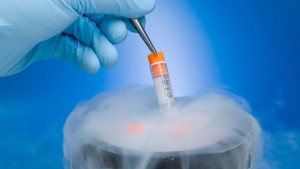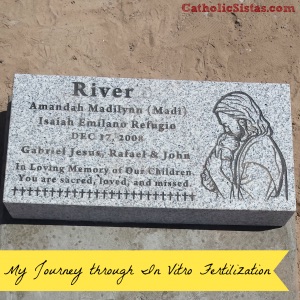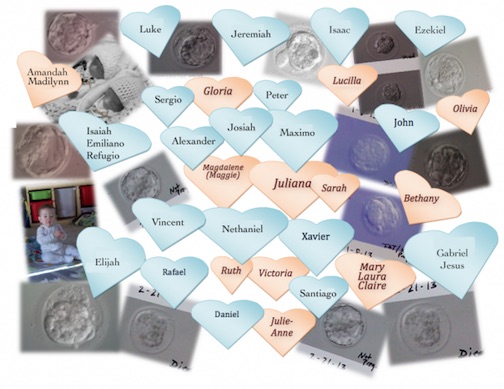My Journey Through In Vitro Fertilization
 It’s July 2008 and I’m strapped to a surgical table as a fertility doctor siphons three dozen eggs out of my ovaries through a long needle. Blood is coming from between my legs, as the needle repeatedly perforates my vaginal walls en route to my ovaries in search of viable eggs. In the next room, my husband is masturbating so fresh sperm can be used to fertilize the eggs.
It’s July 2008 and I’m strapped to a surgical table as a fertility doctor siphons three dozen eggs out of my ovaries through a long needle. Blood is coming from between my legs, as the needle repeatedly perforates my vaginal walls en route to my ovaries in search of viable eggs. In the next room, my husband is masturbating so fresh sperm can be used to fertilize the eggs.
Originally published at CatholicSistas.com.
When we’re done, my ovaries hyperstimulate and I pass out. My abdomen and chest begin to fill with fluid; the anesthesia doesn’t stop the severe pain that fills my body. I struggle to breathe. The doctor stabilizes me, but it still takes nearly a week to recover from the brutal procedure.
The doctor had retrieved 38 good eggs, of which 31 are fertilized. Over the next week, 16 of our embryonic children die and are discarded. Thirteen are cryogenically frozen, mostly two to a vial. Two fresh embryos are transferred to my uterus.
Yes, the cost is high for what we’re doing, both financially and physically. But it will be worth it, I tell myself. Because surely at least one of these embryos will give us our heart’s desire–a beautiful child of our own.
Justifying Our Choices
My journey into in vitro fertilization (IVF) actually began in the 1980s, when my mother used donor sperm and intrauterine insemination to conceive me and my twin sister. When we were 12, we discovered that the man we thought was our father was not. I was disturbed that we were created by my mother and a stranger, and have always felt as if only part of me was “real.”
Fast-forward to my own marriage in 2004. We wanted children right away, but a year of trying had resulted in no pregnancy. I was diagnosed with polycystic ovarian syndrome, an endocrine disorder that inhibits regular ovulation.
Doctors put me on the same ovulation-stimulating medication my mother had used to conceive me–Clomid. Four unsuccessful cycles later, we moved on to artificial insemination, though we did at least use my husband’s sperm. Still no baby.
In desperation, we graduated to the expensive and complex process of IVF, where my eggs and my husband’s sperm would be taken out of our bodies, joined in a petri dish, and the resulting embryos would be inserted into my uterus.
Even before we started down the IVF road, there was a voice inside of us whispering that it was wrong. But that voice was drowned out by louder, more persistent voices, like the doctors’ who said we had little to no chance to conceive without it. Friends and family, too, supported anything that would end the suffering of our infertility.
Then there was my own desire for a child, shouting down the doubts and assuring me that God would want me to be happy and that, as a woman, I deserved a child. And really, how could science that helps create life be a bad thing?
So we signed the contract and started the IVF process. To prepare, I took hormone injections and pills to stimulate my ovaries for egg retrieval. Though most eggs were fertilized simply by exposing them to sperm, some needed sperm forcibly injected into them with a needle.
These newly formed, microscopic human beings were then graded for quality and we were encouraged to discard “low-grade” embryos that had little chance of survival. But because we couldn’t fully stifle our doubts about the wrongness of IVF, we insisted that all our viable embryos be preserved.
Suffering and Loss
After the first transfer in July 2008, we were thrilled to discover that we were pregnant with twins, due the following April. But at 21 weeks gestation, our twins–Madi and Isaiah–were born prematurely and only lived for one hour each. During those brief, heartbreaking few hours, we held them, bathed them, dressed them, and baptized them, holding onto their tiny, fragile bodies as long as we could.
For the next year, I floated numbly through life. I believed the twins’ death was God punishing me for my past sins. My husband remained silent. Through it all, my heart was torn about the route we’d taken, as well as the fact that we still had 13 frozen children whose lives were on hold.
Eventually we felt ready to try IVF again. In October 2009, our only singly vialed embryo, Jeremiah, was thawed and transferred to my womb. We did not get pregnant.
In February 2010, we did another transfer. The embryologist came into the room beforehand and said that “one expanded and one did not.” We knew then that our son, Luke, had survived thawing, but that our daughter, Lucilla, had died and been discarded. In the end, Luke died, too, and we did not get pregnant.
Three months later, we thawed another vial and both Elijah and Ezekiel survived. The situation was complicated, however, because the death of the twins at 21 weeks had shown I had an incompetent cervix. This made carrying even one baby risky. We decided to transfer only one of the boys, because I would likely lose both if they developed properly after being transferred to the womb. Elijah was transferred and we were ecstatic when he was born in 2011.
His brother, Ezekiel, didn’t make it. But he was so, so resilient; he was initially frozen, thawed, refrozen, and re-thawed, yet survived to be transferred in January 2012. We did not get pregnant. Three months later, Olivia didn’t survive the thaw, but we were able to transfer Isaac.
A Spiritual Awakening
While waiting to see if I was pregnant with Isaac, I went on my first spiritual retreat. I went skeptical and defensive; I wasn’t going to share what I was going through with anyone. But God gave me a “spiritual spanking.” The poignant lyrics to a song caused me to break down crying and I experienced an intense spiritual awakening. That night, I went to reconciliation for the first time in years.
I had yet to own my sinfulness, however, because in my mind, I was still denying the truth—that I had killed my children through the violent and undignified process of IVF. By the end of the retreat, however, grace had finally washed away my pride and I experienced a full and overwhelming gift of faith.
Overnight, my life went from being about what I wanted to being entirely about the love of God. Two days after I returned from the retreat, we discovered that Isaac had died, too, and I was not pregnant.
After seeing my transformation, my husband went on the same retreat in May. He had several profound spiritual experiences of his own, where he felt the Lord lift the guilt from his heart. God assured him that our deceased babies were safe and loved and would be waiting for us in heaven.
But faith didn’t solve the problem of what to do with our still-frozen children. We could leave them frozen, discard them, donate them to scientific research, or adopt them out. We felt all those options were disrespectful to the children and we feared they were offensive to God, too.
We’ve since learned that the Catholic Church hasn’t fully clarified what is the most morally prudent and loving route to take when dealing with frozen embryonic children and theologians are all over the map on the issue. Some say every child created deserves a chance at life and ought to be implanted, as we did; other theologians suggest embryonic babies should be baptized, thawed until they pass away, and then buried. Hopefully the Church will soon define the best course for frozen IVF children, but until then, couples in our situation can only seek counsel through their spiritual advisers and through the Holy Spirit, in prayer.
We went into the first of the final three transfers in August 2012. Though I had been through the process before, this time was different; sadness consumed me as I sat in the clinic waiting room. I felt God’s pain from all the lives discarded by doctors and parents, who often create embryos only to throw away the “surplus” to save storage fees or get rid of lesser quality ones. I saw the cold beginning and end of so many of my babies’ short lives–first in a petri dish, then in and out of a freezer, and finally discarded like trash.
Vincent survived thawing and was transferred to my womb. Raphael hadn’t survived, however. We’d learned from our priest that if a baby didn’t survive, we had to save his body and bury him properly in holy ground, just as we would a born child. So this time I told the embryologist we wanted the “bodies” of any babies who didn’t survive the thaw to take them home to bury.
I remember it so clearly–the embryologist walked out of the lab, cradling the vial containing Raphael. She had a very solemn look on her face and was very respectful. I knew she was Catholic, too, and I can’t help but wonder how that experience affected her. Vincent didn’t survive transfer, either, though, and we did not get pregnant.
Four months later, we transferred Bethany; John didn’t survive the thaw. I was able to keep John’s body in a vial as we had Raphael’s. We did not get pregnant.
The final transfer took place in February 2013. Mary Laura Claire was transferred, and we carried her brother, Gabriel Jesus, out in a vial as we had his two brothers before him. We did not get pregnant.
When our twins died, we had them cremated and placed their remains inside small pewter hearts that had been sewn into “Build a Bear” animals. We kept them on a shelf in our bedroom for five years. As we grew in faith, so did our knowledge that those babies, too, deserved to be buried respectfully. Five months ago, we went home to New Mexico, and buried our twins with their three embryonic brothers.
After nine transfers and 30 babies, our IVF journey had finally come to an end.
Realizing the Truth about Life
Earlier this year, I went on a retreat for post-abortive parents, since I felt that what I’d done to my babies through IVF was similar. I felt mixed vibes from others there, possibly because most people don’t understand the complexity of IVF. But if life starts at conception, then you can have sorrow and regret for denying your children life through IVF, the same as you do with abortion.
At one point, I was sitting outside. The sun was warmly bathing my face, but inside I was in turmoil. In my mind, I saw two ribbons–one expressed was the violence, darkness, and sinfulness of humanity, while the other showed the beauty and sacredness of human life.
I suddenly understood just how sacred every single person is to God. I realized how selfish my decisions had been in allowing my babies to be violently injected into my uterus after they’d endured the indignity of freezing and thawing. Yes, the violence paralleled that of abortion.
The similarities were further brought home to me when I read over the IVF and cryopreservation contracts for the first time a month later. I felt brokenhearted and ashamed as I read the dehumanizing language describing that most sacred process of creating human life.
Our babies were described as “cryopreserved material,” “concepti,” and “orphaned specimens.” Another section gave the clinic permission to take “Title” (ownership) of our embryos if we stopped the process, as if our children were commodities like cars. This consumerist mentality, combined with the emphasis on “cost effective treatment,” is what makes it acceptable for IVF children to be donated for research, abandoned, discarded, and even aborted through “selective reduction” when too many embryos stay alive after transfer.
The contract also stated that, “It is rare for an embryo to not survive thawing.” Half of our babies didn’t survive thawing. And, “Occasionally, an embryo is not found in the vial due to the nature of embryos to stick to the vial or pipette.” What incredible dangers we’d exposed our children to! Only one phrase in the entire contract spoke to the humanity of our children by calling them babies.
Being created in a lab and then frozen violates the dignity of these tiny human beings. Thawing and discarding is killing. Reducing women to incubators and men to sperm donors is also undignified. Children have a right to be the fruit of their parents’ loving union, not products to be bought, sold, donated, or trashed.
There are still days when my sorrow about our children and the IVF industry itself becomes nearly unbearable. It’s hard to accept that we consented to what we did, but the desire for a child is so primal and powerful and we understand the desperation that drives couples to IVF. I take consolation in what God said to Habakkuk: “WAIT! I am here through it all! And I am establishing a work in my people that you cannot imagine! Be ready and willing when I call you.” I offer this story of our family’s journey through IVF, with its perils and heartbreak, as my expiation and my fiat–“Father, You are my only source of strength; my very existence. I am your instrument; do with me as you will!”
[editor’s note: Jenny’s story continues in this exclusive Catholic Sistas podcast]



